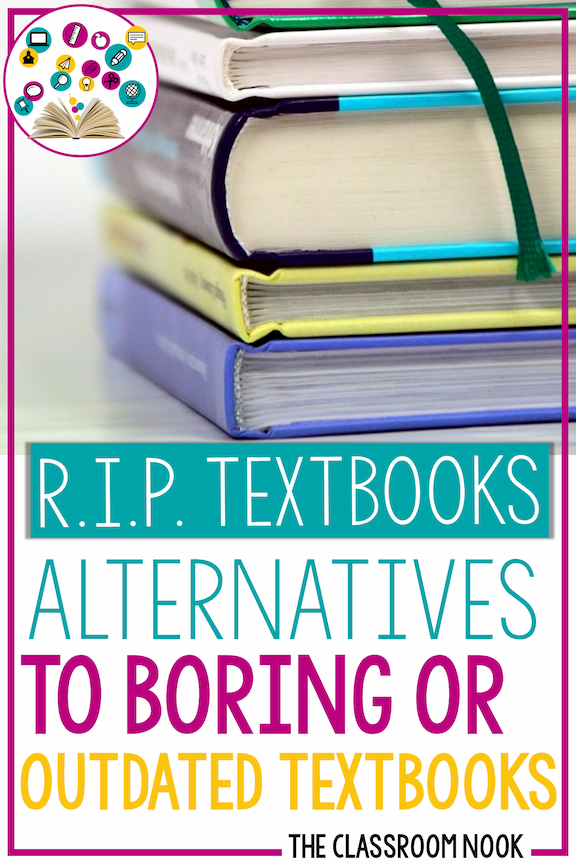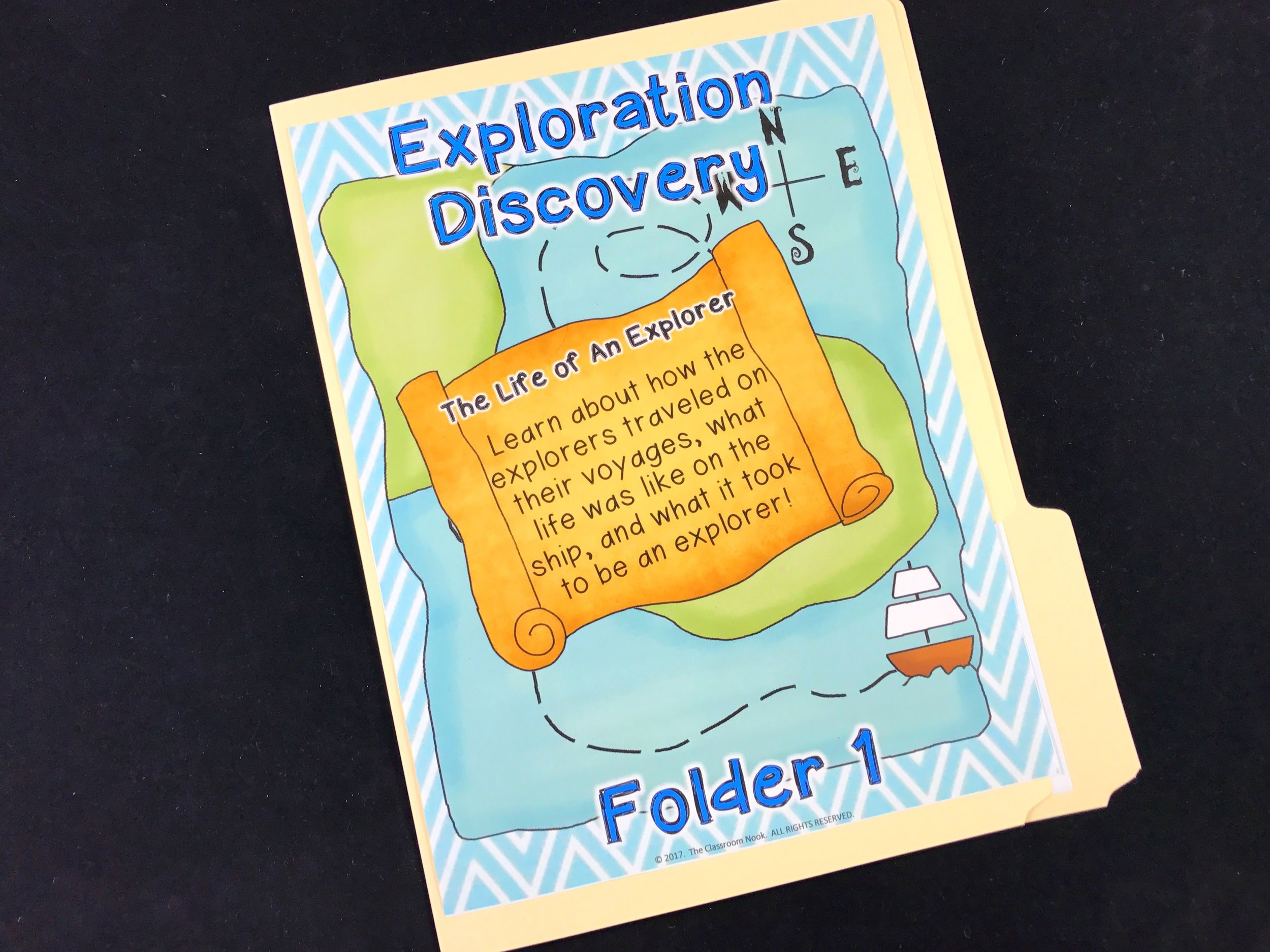RIP Textbooks - Alternatives to Boring or Outdated Textbooks
Love podcasts? Listen to this post in the form of a podcast episode on The Classroom Commute Podcast

It was my first year of teaching. 1 week before school, I was hired to teach 4th grade in a hot little classroom on the second floor of a very old building (I believe it was built in 1912, and I'm pretty sure not too much had been done to it since).
I was the lucky heir to a classroom previously occupied by a teacher that was now basking in the glory of retirement. So what did that mean? I got all the crap that said retired teacher didn't need anymore and couldn't pawn off to their coworkers. The teacher had left pretty much everything that he didn't want to deal with on the shelves of the classroom. And there it all sat, all summer long collecting dust.
Among the rubble - a class-set of social studies textbooks....from 1978. Yikes. Please tell me that these were not the current books that the students were using. I mean, I get that the facts about the American Revolution hadn't changed much since the late 1700's, but come on!
Alas, they were.
How about you? What's the copyright on your textbooks? Are they from the 20th century (because that was almost 20 years ago now! Hard to believe!)? Are they so boring that you can't even begin to fake it in front of your students?
THERE'S A BETTER WAY!
OK - what I'm about to share with you is NOT a quick fix, and I don't want to make any false claims that in 10 minutes or less you're going to have a solution to your textbook woes.
But - what I AM going to share with you is that with a little work, you could have an amazing, more engaging textbook alternative that you'll be proud to present to your students.
And you, dear teacher, are a go-getter, so let's do this!
But - first, let's take a moment of silence to mourn the life of the textbook.
{insert moment of silence here}
OK - I'm ready to move on with my life, how about you?
Let's talk about some of the textbook's alternatives:
TEXTBOOK Alternative: GALLERY WALK
A gallery walk is a fabulous way to present new information to students that allows them to move around and interact with objects, pictures, and each other while learning new content.
If you're unfamiliar with a gallery walk, here's an overview:
A gallery walk is when you set up several sections or stations around your classroom with pictures, artifacts, posters, and other objects about a topic. Each station exhibits something different about that topic. Students walk from station to station collecting information on an activity sheet or notebook. Each station might also have a piece of chart paper near the pictures and objects for students to jot down questions, thoughts, or things that they notice about the content presented at that station.
For example, to introduce different vertebrate and invertebrate animal groups during my animal unit, I created several posters, one about each animal group, for students to examine at each station. Along with the poster, I had picture cards with examples of animals found in each group. Also at the station could be books, articles, or any other object that relates to that animal group.
As students went around observing each animal group station, they recorded information in their "student field guide" (that's code for student activity packet presented in a cute format :) ) There was also a piece of large chart paper and markers placed at each station for students to create a graffiti-like poster where they jotted down words, phrases, or even questions that came to mind about the animal group.
A reverse activity for a gallery walk would be to have STUDENTS create the content to place at each station as a review of what they already learned. This would be a perfect authentic end-of-unit project for students to work on. You might have each student choose or be assigned a sub-topic from your unit and create a visual representation to be placed in your student-made gallery walk.
In short - take the content that is presented in your textbook and transform it into a more visual representation to be presented in a gallery walk.
TEXTBOOK Alternatives: READER'S THEATER
Have I ever talked about my love for creating reader's theater? If you've ever used any of my resources, you've likely come across a reader's theater script that I created to help teach students about a potentially boring topic.

Take pollination for example. Reading about it in a textbook is a sure-fire way to lose your students' interest faster then they lose pencils. Put that same content in the form of a cute reader's theater where bee characters are narrating the process of pollination in humorous dialogue, and well...your students may still lose their pencils, but they'll be able to tell you how flowers are pollinated!
I can't think of a single topic that you can't make-over with a little theater. Here are some topics that I've created a reader's theater for:
"Live From Space!" - a reader's theater about newscasters interviewing astronauts traveling to the sun. (from my Sun, Earth, and Moon unit)
"It's a Cycle!" - a reader's theater about the characters "Big Drop" and "Little Drop" discussing the water cycle (from my Measuring Matter unit)
"Busy Bees" - a reader's theater about pollinators traveling a garden discussing pollination along the way (from my Plants unit)
"How the Bear Lost It's Tail" - a reader's theater using a legend to introduce the topic of animal inheritance (from my Animals and Ecosystems unit)
See? It can be done for anything! No, really - ANYTHING. It's really not as hard as it may seem. I simply take the information that I want students to learn from the textbook, and create characters to spit out that information in their dialogue. If I can throw a little joke in there every now and then that I know will make the kids chuckle, great!
You May Also Like to Read: 5 REASONS WHY YOU SHOULD USE READER’S THEATER IN YOUR CLASSROOM
TEXTBOOK Alternative: DISCOVERY FOLDERS
Another format I like to try when I need to present textbook info in a more flashy way is to use discovery folders. A discovery folder is what I like to call a file folder with flare :)
Here's how it's done:
STEP 1 - Choose a topic that your textbook covers, but in such a way that puts you (and your students) asleep. I've done discovery learning folders for Native American regions in North America, political decisions made during the Civil War, biomes, early European explorers and major battles of the American Revolution to name a few. I broke each topic into several sub-topics and created one discovery learning folder per sub-topic.
For example, for my early European explorers learning folders, I had one folder that discussed life as an explorer (shown below), another folder that discussed reasons for exploration, a third folder for presenting content on the countries that were involved in the Age of Exploration...and so on. Students then rotated through the folders. If you only need one folder for your topic, then you can create several copies so that students can still work in small groups.
STEP 2: Open up a blank PowerPoint presentation (or whatever tool you used to create student resources). Create a cute cover page that includes the topic (or sub-topic) that students will be reading about. Add some cute clip art and images.
STEP 3: Create up to 3 pages that contains the information that you want your students to learn. This information can come right from your textbook. Pull out the information that your students need to know, but use more colorful language that you know will interest your students. You can group the information into sections by using different headings and include lots of pictures, maps, diagrams, whatever visual will help students best understand the content. I sometimes like to include a few discussion prompts for students to talk about when they are in their groups. I put these on the last informational page. You can also sprinkle discussion prompts throughout so that students use them as they work through the folder.
STEP 4: (Optional) Include an extension activity for students to complete after they've gone through the folder. These activities might include a word sort, coloring and labeling a map or diagram, completing a page for an interactive journal...etc) Above, you see that when students were looking through the folder on an explorer's life, they were asked to label the parts of an explorer's ship.
STEP 5: Glue your informational pages on the inside flaps of your folder as well as on the back if you have a 3rd page. Laminate if possible - you're gonna want to use this babies year after year!
Try them out! They'll be a big hit for sure!
If you’re looking for some ready to go, you can snag one that I’ve already created. Check them all out here. Just click on each picture for more details!
TEXTBOOK Alternative: LINKtivity DIGITAL LEARNING GUIDES
Alright - so if you know me and my teaching style, then you know I can't write a post about ways to replace a textbook and NOT include LINKtivity digital learning guides! If you’re totally new to LINKtivities, then:
You May Also Like to Read: ENGAGING LEARNER WITH LINKTIVITY DIGITAL LEARNING GUIDES

In short, LINKtivies are interactive PDFs or google slides where students can click around the guide at their own pace to learn new information. Then can even have links to outside websites that students can visit to take their learning even deeper. They're basically your one-stop shop for learning!
I saved this textbook alternative for last, because I'm fully aware that it takes the most prep on your part, but I also believe that you'll get the biggest bang for your learning buck as well!
Students. love. LINKtivities. PERIOD! They love 'em!
They can learn at their own pace, on their own digital device, and feel like they are playing a game the whole time!
Once you begin using them, you will find that your students will craaaaave them! Not only do LINKtivies teacher students important content in a kid-friendly way, but they also enhance their learning by linking out to YouTube videos and kid-friendly websites that will allow your learners to experience the content on a deeper level.
Get access to my entire library of LINKtivities inside the LINKtivity® Learning Membership!
Well, there you have it: 4 modern alternatives to using textbooks in your classroom!













